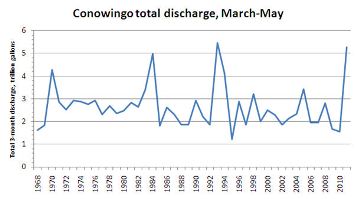The upper Chesapeake Bay experienced record-low salinity levels following near-record discharge from the Susquehanna River this spring.
Data from the Annapolis CBIBS buoy show that the drop in salinity started in April 2011 and started to reverse in June, and the drop was about 7 units, falling from about 8 in April to near 1 in May. By contrast, in 2010, there was a steady increase in salinity during this period.
Salinity, a measure of the saltiness of the Bay’s waters, is one of the key aspects of water quality measured by CBIBS buoys. It determines which plant and animal species can live where, when and where they can reproduce, and many other factors. Open ocean salinity is about 33-38 and fresh water is about 0. Salinity—formerly expressed in “parts per thousand (ppt)”— has no units.
Because the first buoys in the CBIBS system were deployed in 2007, CBIBS buoys have not been in place long enough to compare their results to historical ranges. But salinity results from traditional fixed-station monitoring in the upper and mid-Chesapeake Bay, conducted once or twice a month by the Maryland Department of Natural Resources since 1985, show record low salinity values at many sites in spring 2011.

Daily median salinity values from the mouth of the Severn River near Annapolis from the CBIBS buoy, with 2011 data (solid blue) compared to 2010 data (light gray).
While the whole Bay and its tidal rivers hold about 15 trillion gallons of water, there is only about a tenth of that volume (about 1.5 trillion gallons) north of the Bay Bridge, because most of that part is so narrow. Was the inflow from the Susquehanna in spring 2011 high enough to lower the salinity near the Bay Bridge by about 7 units in less than a month? Real-time data on discharge (water flow) collected by the U.S. Geological Survey at the Conowingo Dam on the Susquehanna since 1968 show that higher than normal spring flow in 2011 started in early March and continued through April and May, returning to near normal levels in June.
The total March-May 2011 discharge from Conowingo was more than 5 trillion gallons (Fig. 2), equal to more than three times the volume of water in the upper Bay. That was enough flow to replace the water in the upper Bay once a month, probably causing the observed drop in salinity near Annapolis. The normal spring discharge is 2-3 trillion gallons. The 2011 spring discharge was just below the record high set in 1993 when it was 5.5 trillion gallons; in 1993 (and 1994), the upper Bay also experienced low spring salinity.

Total spring discharge (in trillion gallons) from Conowingo Dam by year, 1968-2011.
What do these record low salinities mean for the upper and middle Bay in 2011?
- Higher than normal freshwater inflow usually brings more suspended sediment and dissolved nitrogen into the upper and middle Bay. Increased dissolved nitrogen can trigger algae blooms, and increased suspended sediment can cloud the water. Indeed, in May 2011, a number of monitoring sites in the upper Bay had record low water clarity. The turbidity levels at the Annapolis buoy were also elevated from mid-April to mid-May, compared to earlier and later data.
- Low salinity inhibits oyster spawning and survival of young oysters, and thus causes problems for both oyster hatcheries and restoration. Most of the oyster planting that was planned in Maryland for 2011 is on hold until the water is salty enough for the spat on shell to survive (salinity needs to be at least 6). On the plus side, low salinity discourages one of the diseases of oysters, MSX.
- Wet, low salinity years usually restrict sea nettles (jellyfish) to the lower Bay, where salinity is higher.
- Pulses of low salinity can trigger spawning in a small native bivalve, the dark false mussel. It was locally abundant in rivers near Annapolis in 2004 after a wet year in 2003.
- It is not yet known if low salinity will affect the similar-looking invasive zebra mussels that were seen in the Susquehanna River below Conowingo in small numbers in 2010. They are usually found at lower salinities than dark false mussels.


